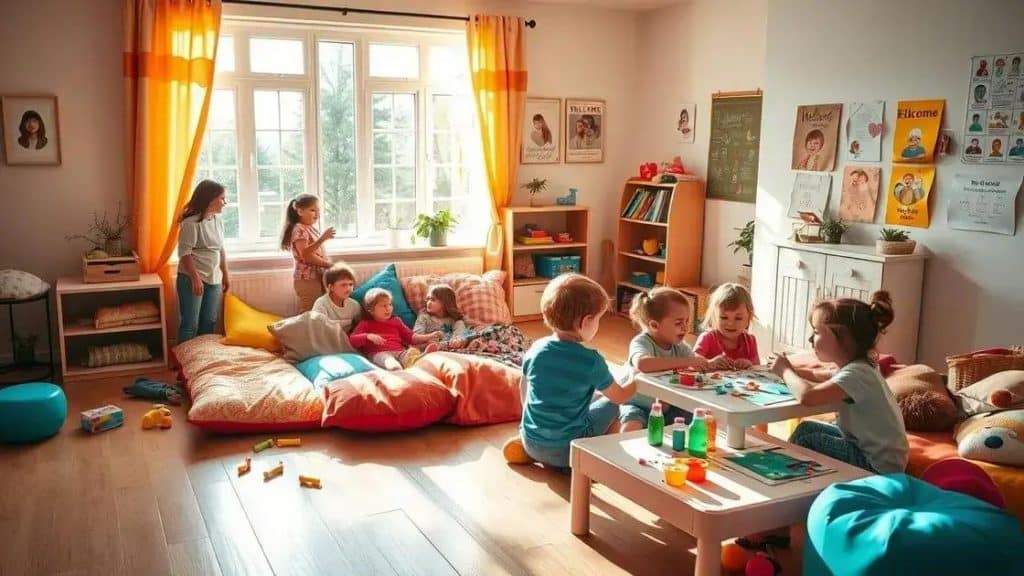Foster care housing programs: a critical need for children

Foster care housing programs provide safe environments for children unable to live with their biological families, focusing on stability, emotional support, and community involvement to promote healing and growth.
In today’s society, foster care housing programs are essential for ensuring that children in need find safe and nurturing environments. Have you ever wondered how these programs operate and their impact on families? Let’s dive into this important topic.
Understanding foster care housing programs
Understanding foster care housing programs is fundamental for anyone interested in making a difference in the lives of vulnerable children. These programs aim to provide temporary homes for children who cannot live with their biological families. By learning more about them, we can all contribute to improving their effectiveness.
These programs vary widely depending on the jurisdiction and resources available. In many cases, local governments and nonprofits work together to ensure children are placed in safe environments. They provide not just a roof over their heads but also emotional support and guidance.
The Goals of Foster Care Housing Programs
At the heart of every foster care housing program are a few core objectives:
- To provide a safe and stable environment for children.
- To ensure the emotional and physical well-being of children in care.
- To facilitate reunification with their biological families whenever possible.
- To help children find a permanent placement, whether through adoption or guardianship.
Foster care housing programs also focus on the needs of different age groups. For instance, younger children may require more intensive care and supervision, while older teens might benefit from programs that emphasize independence and life skills. This targeted approach helps meet the unique needs of each child.
The Importance of Support Services
In addition to providing housing, support services are crucial for the success of these programs. These services can include:
- Counseling for emotional and psychological health.
- Educational support and tutoring.
- Life skills training that prepares children for adulthood.
- Recreational activities that promote socialization.
Support services not only improve children’s immediate situations but also aid their long-term development. When children receive the necessary care and support, the likelihood of positive outcomes increases significantly.
Understanding how foster care housing programs operate gives us insight into their challenges and successes. By actively participating or supporting these programs, we can help create nurturing environments that make a difference in children’s lives. This effort requires community involvement and awareness, as we all have a role to play in shaping the future for these children.
Benefits of foster care housing for children
Benefits of foster care housing for children play a significant role in shaping their future. These programs offer stability and support during some of the toughest times in a child’s life. By understanding these benefits, we can see how impactful these housing options are.
Foster care provides a nurturing environment for children who have faced trauma and instability. One major advantage is the sense of safety it brings. When children know they have a secure home, they can focus on healing and growth. This security contributes to better mental health and emotional well-being.
Educational Support and Opportunities
Another important benefit is access to educational resources. Foster children often receive assistance in their academic pursuits, which can help them thrive in school.
- Individualized tutoring sessions to address learning gaps.
- Access to extracurricular activities that enhance skills.
- Support for college preparation and applications.
- Stable school environments that allow for consistent learning.
Such educational support not only helps in immediate learning but also sets the stage for a promising future. Many foster care housing programs ensure that children stay in the same school, providing continuity in their education despite changes in their living situations.
Emotional and Social Development
The emotional and social development of children in foster care is enhanced by strong support systems. These programs often involve therapy and counseling services:
- Access to mental health professionals who understand trauma.
- Opportunities for peer interactions in safe settings.
- Family engagement that helps maintain relationships.
- Life skills training that encourages self-sufficiency.
These services help children process their experiences, build resilience, and develop healthy relationships. When children learn to navigate their emotions in a supportive environment, they are more likely to succeed in their personal and academic lives.
The overall impact of foster care housing programs extends beyond immediate needs. By providing stability, educational opportunities, and emotional support, these programs play a pivotal role in guiding children towards successful futures—an outcome that benefits society as a whole.
How to get involved in foster care

How to get involved in foster care is an important topic for anyone looking to make a positive impact in the lives of children. Getting involved can take many forms, and every effort counts toward improving the circumstances of these young individuals.
One of the first steps to getting involved is to educate yourself about the foster care system. Understanding the rules and needs of foster care can help you determine the best way to lend your support. You can start by reading books, attending workshops, or joining online forums dedicated to foster care.
Become a Foster Parent
Becoming a foster parent is one of the most impactful ways to get involved. This process includes:
- Undergoing a thorough background check and home study.
- Receiving training in parenting and trauma-informed care.
- Providing a stable and loving environment for children in need.
- Maintaining communication with social workers and biological families.
Foster parents play a crucial role in helping children heal and thrive. It is essential to approach this commitment with an open heart and a willingness to support children through their challenges.
Volunteer Your Time
If becoming a foster parent is not feasible for you, consider volunteering your time. There are various organizations that welcome volunteers:
- Mentor young people in foster care.
- Assist with fundraising efforts for local agencies.
- Join support groups and community events.
- Offer tutoring or educational support to foster children.
Volunteering can significantly enhance the support network for children in foster care. Every little bit of time and effort can provide comfort and resources to those who need it most.
Advocate for Foster Care Improvement
Another way to get involved is by becoming an advocate for foster care reform. Advocating can include:
- Contacting local representatives to discuss foster care policies.
- Raising awareness on social media about foster care issues.
- Participating in public forums and community meetings.
- Collaborating with local organizations to promote foster care initiatives.
By advocating for change, you can help improve the foster care system, ensuring that more children receive the support and resources they deserve. Your voice can influence policies that benefit children and families in need.
In summary, there are numerous ways to get involved in foster care, from becoming a parent to volunteering and advocating for change. Each of these roles is vital for enhancing the lives of children in foster care and creating a brighter future for them.
Challenges faced by foster care housing programs
Challenges faced by foster care housing programs significantly impact the effectiveness of these vital services. Understanding these challenges is necessary to create better solutions for the children and families involved.
One major challenge is the shortage of qualified foster homes. Many potential foster parents may hesitate due to the extensive requirements and emotional stresses involved. This shortage leads to overcrowding in existing placements, making it harder for children to receive the individual attention they need.
Emotional and Behavioral Issues
Another serious issue is the emotional and behavioral problems that many children in foster care face. These issues can arise from past traumas and instability.
- Children may experience anxiety or depression.
- Behavioral issues can disrupt the home environment.
- Some children may struggle to form healthy relationships.
- Therapeutic interventions often require significant resources.
Addressing these emotional challenges requires a comprehensive support system, including counseling services and trained care providers who understand the complexities of trauma.
Funding and Resources
Funding disparities create obstacles in providing adequate resources for foster care programs. Many agencies operate on tight budgets, affecting their ability to offer necessary training and support.
- Limited funds can lead to fewer support services.
- Programs may struggle to provide essential training for foster parents.
- Cuts in funding can result in a lack of mental health resources.
- Many organizations rely on donations, which can be inconsistent.
This underfunding can directly affect the quality of care that children receive, hindering their development and stability.
Regulatory Complexities
Regulatory requirements can also pose significant challenges. Different states have varying laws and regulations that foster care programs must adhere to.
- Navigating these regulations can be time-consuming.
- Changes in laws can create uncertainty for foster families.
- Compliance can place added pressure on social workers and agencies.
- Difficulties in meeting state requirements can hinder the ability to place children quickly.
Addressing these complex regulations often requires increased collaboration between agencies to streamline processes and improve outcomes for children in care.
By identifying and working to overcome these challenges, foster care housing programs can provide more effective support to children and families. Raising awareness about these issues is crucial to inspire action and encourage community involvement.
Future of foster care housing initiatives
The future of foster care housing initiatives holds great potential for improving the lives of vulnerable children. As society becomes more aware of the challenges faced by the foster care system, innovative solutions are emerging.
One promising direction is the increased focus on community-based approaches. By engaging local organizations and neighborhoods, foster care programs can create more stable environments for children. This collaboration helps build support networks that both children and foster families can rely on.
Utilizing Technology
Another key development is the integration of technology. New tools are being used to streamline processes and enhance communication.
- Online platforms can connect foster families with resources and training.
- Data analytics help identify trends and improve service delivery.
- Virtual support groups offer a sense of community for foster parents.
- Mobile apps can assist in tracking the progress of children in care.
Technology not only makes the system more efficient but also allows families to access support more readily, breaking down existing barriers.
Promoting Trauma-Informed Care
Another important trend is the emphasis on trauma-informed care. As awareness grows regarding the effects of trauma on children, more programs are adopting practices that promote healing.
- Training foster parents in understanding trauma responses.
- Implementing therapeutic techniques in daily routines.
- Creating safe spaces for children to express themselves.
- Providing access to mental health professionals.
This shift aims to create environments where children feel safe and supported, allowing them to thrive emotionally and socially.
In addition to these trends, there is a growing push for policy reforms that focus on the needs of children in the foster system. Advocates are working tirelessly to ensure that lawmakers prioritize foster care improvements. Advocating for increased funding and resources, along with better training for foster parents, is essential for transforming the foster care landscape.
Overall, the future of foster care housing initiatives is paving the way for more effective and compassionate care for children. As communities, technologies, and advocacy efforts evolve, the potential for positive change in the lives of these young ones continues to grow.
In conclusion, the future of foster care housing initiatives offers hope for improving the lives of children in need. With community involvement, advancements in technology, and a focus on trauma-informed care, we can create better environments for these vulnerable youth. Advocating for policy changes and increased resources will further enhance support systems. By working together, we can ensure that every child in foster care receives the care, love, and stability they deserve.
\n
\n
FAQ – Frequently Asked Questions about Foster Care Housing Initiatives
What is the purpose of foster care housing programs?
Foster care housing programs aim to provide safe and nurturing environments for children who cannot live with their biological families.
How can I get involved in foster care?
You can get involved by becoming a foster parent, volunteering your time, or advocating for policy changes to improve the foster care system.
What challenges do foster care housing programs face?
Challenges include a shortage of qualified foster homes, emotional and behavioral issues among children, and funding disparities.
What is trauma-informed care in the context of foster care?
Trauma-informed care focuses on understanding and addressing the effects of trauma to create supportive environments for children in foster care.





